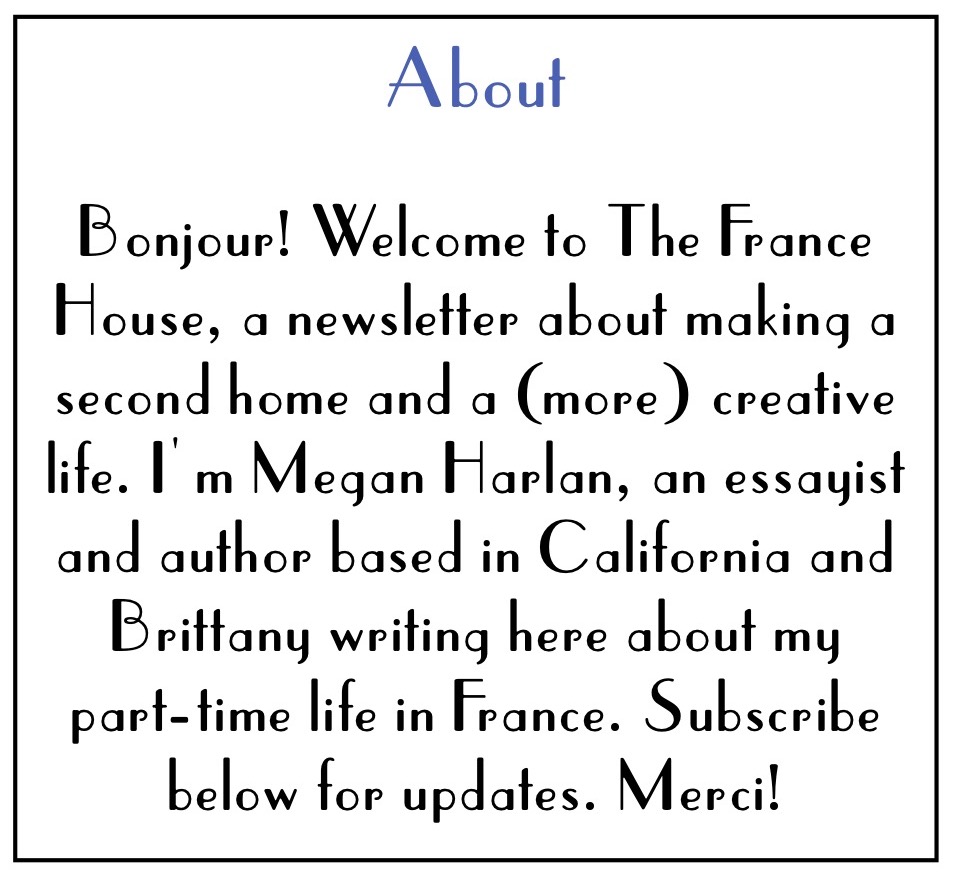On Brittany’s storied textile history—involving the Bayeux Tapestry, Shakespeare, and the “blue gold” rush.
By Megan Harlan
Once upon a time, as an undergraduate at a nice “potted ivy” college, I took a graduate-level course called Women in Medieval Art and Literature, team-taught by a female art historian and a male literature professor. This may not sound like a earth-shaking experience, yet it was for me. As a teenager in 1980s Northern Califonia, I’d attended Catholic schools at a time when American Christianity was still recovering aesthetically from hit musicals like Jesus Christ Superstar and Godspell, where Jesus was depicted as a foxy fair-haired guru, while the main “role for women” besides Mary was a hot prostitute. (Never mind that Mary Magdelene was never a sex worker: Broadway and Hollywood had audiences to attract.) Beyond the dire stories of martyrs, I’d never before encountered the profound roles women once played in Church culture and the arts—way back in medieval times, true, but better than never. Hildegard of Bingen, Julian of Norwich, Margery Kempe, Clare of Assisi—these and other brilliant female artists, visionaries, and leaders were new to me. I loved that class so much, I grew awfully close to veering off the already-lucrative English major trajectory I was on and happily burying myself in the medieval history department.
Among the class’s highlights was the Bayeux Tapestry—a sprawling and rollicking miniseries in embroidered linen depicting the incredible saga of 1066: that pivotal year when William the Conqueror lead the Norman invasion of England, the Saxons fell, and French colonization, culture, and language transformed the British Isles forever. The Bayeux Tapestry is one of Western medieval art’s greatest works—and it was created by women, by about 1180. (The identity of its designer—if there was one such person—is unknown and has long been contested: Original French tradition has William’s wife, Queen Matilda, as its author; some recent scholarship posits that the widowed English Queen Edith designed it, as a story of reconciliation between her own Saxon people and their new Norman rulers.)
In any event, the artwork is unlike any tapestry you’ve ever seen. In 2019, when my family visited its museum in Bayeux, a cathedral town in Normandy, I’d failed to grasp just how enormous it really is: Running 244 feet long, the Bayeux Tapestry spans the length of a soccer field and takes at least an hour for viewing—especially if you stop to appreciate the cast of thousands and the entertaining zoology and marginalia stitched along the borders. The grandiose scale of the story-telling makes it unique in textile art, but its colorful “primitive” style renders it at once accessible, strange, touching, and often pretty funny to viewers today—like one long fabric comic book.
This partially animated version gives a cheeky, helpful 20-minute overview of the whole thing:
a narrated speed-read of the Bayeux Tapestry
As the post’s header image shows, Dinan played a role in the battles leading up to 1066—sustaining attacks by William the Conqueror—and so its ancient castle is featured on the Bayeux Tapestry. (Or as the end of that sentence reads to me: the Bayeux Tapestry!)
From the France House—like all of Dinan located within the medieval walls—we can walk out the front door and down a road or two to this castle, or at least its descendant. Today the castle looks very different from the wooden structure depicted in the tapestry. It was in fact the Normans—the so-called “castle-builders”—who invented and spread across Europe the “technology” of the castle, as we think of this building today: the stone fortress with tower, moat, soaring sheer walls, and huge gates. This describes Dinan’s château, which dates to the 1300s and 1400s (more on the monument in a future post):

view of Dinan’s castle tower (from the Promenade de Petits Fossés)
Back to the Bayeux Tapestry: the “screen” on which the embroidered action unfolds is bleached linen. This fabric was once so prized and lucrative it was dubbed “blue gold” (l’or bleu in French, an aour glaz in Breton). Brittany was a headquarters of linen production for many centuries—and this textile industry and trade was long responsible for much of the region’s wealth.
Why blue gold? Linen thread is spun from the fiber of flax plants, which look like this in flower:

flax field in bloom
From the Renaissance through the Victorian era, so mighty was Brittany’s artisanal linen-weaving industry, its reach extended to the Baltic (for purchasing the finest flax seeds), Southern Spain’s Andalusia (where Bretons set up local factories), and the New World (so many nouveau riche clients)—not to mention just across the English Channel. Legend claims that Shakespeare’s father, one “John” Shakespeare, was a linen trader and shopkeeper in Stratford-upon-Avon who supposedly visited Brittany on regular buying trips, especially to the large textile fair held for centuries in La Martyre. In fact, in Henry IV, Part 1, Shakespeare mentions that Falstaff’s shirts were made of “dowlas,” a rough linen hailing from Brittany.
In our house, we see examples of vintage Breton linen every day—on our walls. An artisan hired by the previous owner had the innovative idea to source local, monogrammed antique linens and use them as wall coverings. He adhered them with Italian plaster in a way that highlights the fabrics’ natural color, patterns, and textures:

close-up of the vintage monogrammed Breton linen wall-coverings on the top floor

vintage table linens covering wall (left) near dining area

Among Dinan’s many charming shops is Maison Bleu Lin, which specializes in vintage Breton linens, including many intricate antique pieces. Though the industry has slowed over the last century, a revival by new, local linen producers and fashion designers interested in this sustainable, versatile, and subtly beautiful fabric is underway.
I’m delighted by this revival: Textile arts are among my favorite visual art forms, despite their common designation as mere “craft.” All the better that we may wear this form of art, use it at our tables and on our beds—and so enjoy it in our most daily, practical items. And I find it touching and inspiring that from the very beginning, textiles are a testament to the secret history of women’s artistry.

My partner, aka Matt, by chance color-coordinated with the Maison Bleu Lin in Dinan










